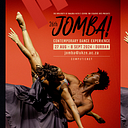Contemporary dance tackling social issues
By Kholeka Ngcobo
Helge Letonja from Germany is the choreographer of the intriguing UN-ZEIT that confronts the current situations and environments that the world is facing. The use of fog and lighting by Laurent Schneegans left me waiting, eagerly anticipating what will happen next or where will the dancers appear next. The dancers portrayed how they work with, and out of time with their fluid and staccato movements with moments of deep release as postures squirm and contort throughout the work.
Contemporary dance is a very intimate form that is used to express, often, the unspeakable. It is abstract, it prompts thought and feeling — it’s very human — and so it is a very effective form to use in exploring human nature and human stories. In the beginning of this dance work we are presented with the silhouette of the body of the dancer, we can’t see their face — or any significant detail. The interplay of light and shadow is carried throughout the dance and it speaks to the disorientation and the displacement of contemporary life. In the more intimate moments of the work, the dancers complete each other and are in sync while they scream internally, they rely on each other.
The diverse cast of dancers including Kossi Sebastien Aholou-Wokawui, Casey Hess, Tereza Hlouskova, Myles Hunter, Yen Chu Ku, Mariko Koh, Xavier Lott, Andrea Scarfi and Alice Zucconi offer an embodied narrative of push-pull that explores the construction of time and how it influences us humas at a very fundamental level. The programme note to the work offers that the “perception of time seems to fray, the just ordered movements of the group lose their linearity, individuals fall out of form and move radically; disoriented” — and this is exactly what the work does, skilled dancers move in and out of time with and without each other. The fluidity of their movement, like time seems unending and cyclical — almost hypnotic. The backgrounds of each dancer adds a large amount of value to this dance piece as their uniqueness shows in their diversity, but they blend perfectly together.
Lighting multiplied the shadows of the dancers, manipulating perspective. This dance piece showed the deep connection between the dancers when they were dancing in unison around one dancer being in the middle.
The costumes were the first center of attention as sister German choreographer, Hannah Ma’s ”INVASION(S)” began. The cast of dancers appear on stage combinations of black, white and glitter. The work is acknowledged as a co-creation with “The People United” and contributing performers and contributors include Durban’s Thobile Maphanga and Jabu Siphika alongside Ritsuko Matsuoka, Sergio Mel, Maher Abdul Moaty, Christin Reinartz, Valentina Zappa, Nora Zrika and Yuri Fortini. In the work, Ma and her co-creators explore invasions. Those that are political and also more personal and intimate invasions. The work is challenging as it refuses any spectacle and dramaturg Sunanda Mesquita does an excellent job in terms of the stretching of time that this work presents.
”INVASION(S)” identifies invasions as violent acts, and yet the work does not propagate or reproduce acts of violence or pain on stage. Rather, as Ma explains, the work is more ritualistic. There is a deliberate sense of community that includes audience and performers. The dancers on stage become nations, territories, armies and political ideas that are the voices of discrimination, oppression and freedom as the work breaths through time.
Video and audio installation and soundscape provided by Sebastian M. Purfürst that sit at the centre of the work, seamlessly guide both performers and audiences through the work as they expand on the different types of invasions that creep in violently and unexpectedly. Nora Amin and Ehab Hapo also provide text, voice and soundscape — what stood out for me were the references to gender-based violence and the violations against woman and female bodies. This dance piece left me thinking of the different ways in which invasions occur, light shining through the darkness, invading it.
A sense of ‘someone is always watching’ permeated the work with its diversity-sensitive choreography that includes dancers from different geographical and cultural backgrounds.
Contemporary dance is used to pass crucial messages that affect people on a daily basis. ”UN-ZEIT” and ”INVASION(S)” are two distinct and provocative works that speak profoundly to our contemporary human condition.
